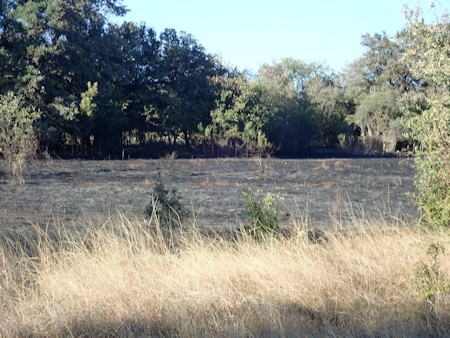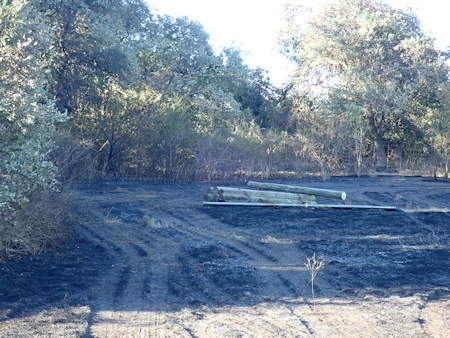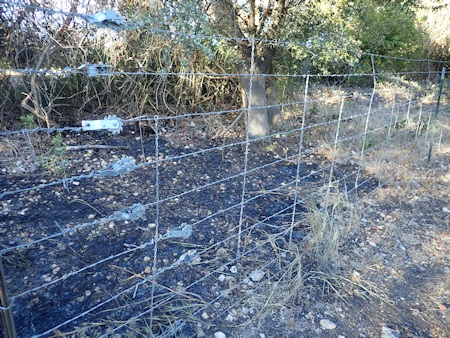R-‘s little orange riding mower caught fire while he was mowing in the field today and started a grass fire that resulted in four different rural fire services responding. It was a tad frantic around here for several hours.
Morning was cooler (and dryer) than yesterday, but it warmed up faster than anticipated, and the little orange mower sits lower than the small green Deere and its mower deck is closer to the engine. So he was taking down ragweed and broomweed–standard late-season chore around here (our neighbor to the south was mowing with a big tractor and towed mower/shredder) and…suddenly heard a loud “pop,” the engine died, and flames were coming out below. They quickly spread to the grass and forbs, and a little breeze sprang up, and soon the field was ablaze, the fire moving quickly to the treeline to the north and the dry woods to the west.
All honor to the fire crews: we still *have* a dry woods, and we think most of the trees on the north fenceline (the highest concentration of live oaks on the place, plus the single post oak) will survive, though with scorched twigs and at least one very unhappy looking limb.
It was quite impressive, and no, I did not get pictures as this was going on, because I was hurrying back and forth…collecting horses from the horse lots and confining them to the barn, so if the firefighters needed another way in I could open the street gate, the lot gates, and let them out into the near meadow, cutting the fence on the south that was near a street in town, in case they needed to get to that side of the old ditch to protect a neighbor’s house (adjacent to the field) and the construction yard (with a neighbor’s help because I didn’t know where our fence tool was since R- incorporated it in the barn’s tool areas)…he had one and helped me cut and then loop the barbed wire back, going back out to see what, if anything I could do to help. I called 911, of course, and then when I first went out saw the flames get into the edge of the dry woods and the north fence trees. Before I could get to a fire truck, or R- who was standing near one (OK, he’s standing, he’s not badly hurt) a line of flames moved up between us and more were sneaking along under cover of tall forbs beside me, I suddenly realized. .
Late in the afternoon, R- went out to take pictures and found some embers smoking and two with little flames. He came back, got the other little tractor with a cart and got two 5-gallon wormer buckets full of water from the lily pond, and took that out. I followed on foot, having retrieved my phone from the charger so I could call the fire dept if I needed to. Sure enough, he got only some of the coals and embers out completely before he ran out of water, so I called 911 again, explained that we had some smoking embers, and a truck came out and wet down the worst places, then said with no wind expected tonight, and everything that *was* still “hot” being in the middle of a large burnt-over area, we didn’t have to worry about it. We came in and ate supper, late, because it was getting dark by then. I awarded myself a Teo gelato soda for the extra walking today because there was a lot.
Photos here taken by R.S. Moon in late afternoon while checking for smoking embers and small additional fires. First two pictures show unburnt grassland (what it all looked like before the burn with some scorching on trees at the margin(1), and the color of unburnt/scorched trees across the road (2) Last picture shows fire across the N fence and into our neighbor’s place.





Too much excitement! Glad you’re all okay!
Way too much excitement, definitely. Horses have settled into “Who knew that smoke in the sky meant more food more often?” and are now announcing “Feed time!” every time I go outside. It’s amazing (and I am so thankful!) that R- didn’t get any burns. I’ll be taking the pictures this morning, along with my morning walk (about to leave for that.) R-‘s gone to check the ember & smoke situation.
And now R- reports that there’s a lot of brown smoke on the northern horizon, NE of us. Poor souls, whoever’s place that is. Tis the season for fires. Lots of stuff grew this year, then dried suddenly…
Wow – glad you and the horses are safe. These things happen. Fortunately the fire people were able to prevent more damage. Now you will be able to see how the land comes alive again after the fire. Stay safe and stay sane,
Jonathan up here in rainy New ampshire
We’ll need water for that…a nice gentle rain for 2-3 days would be ideal, but Texas lacks a Rain Authority who allows ordering the kind of rain, amount, and intervals needed/wanted. A total of 3 inches in quarter/inch/hour segments over a week would be very nice. Just fast enough to avoid sheet erosion of the ash and soil. But our rain list consists of “Texas inches” (drops fall the numbered inches apart), or “Yeah, you’ve been asking for rain for months/years so here”s the backlog all at once, that’ll shut you up” WHOOSH! of the flash floods within the first two hours and all the cricks done riz over everything. Years of “ordinary” rain, arriving in moderate amounts every week or so, are rare. Earlier this year that’s what we had. It was lovely. Usually followed by a bad drought, though. But could be anything with climate change.
Glad you are all ok. Like Jonathan, I was thinking that the land might respond positively to the fire. Here’s hoping you (and your neighbor with the smoke and, while we’re at it, all the folks out west) get all the rain you need. And not via a hurricane either! Where are Rachel Caine’s Weather Wardens when we want them? 😉
There’s some evidence that the land responds positively to fire, but that’s more true for prescribed burns that don’t get out of control and were planned for a specific purpose and conditions, to keep the fire “cool” and easily controlled. There’s uncertainty about how many “natural” fires existed in some unknown original conditions: Native Americans did use fire as a management tool for both plants and wildlife but even the conditions they chose to use aren’t identified for this area. The problem now is that nothing about the conditions is fully ‘natural.” Not the watercourses, not the climate, not the vegetation. This field was part of a larger pattern of tallgrass prairie in an area that wasn’t *all* prairie. Woods along creeks and rivers, and on top of *some* hills and steep slopes, but prairie meadows, some with tree clumps in them and some clear. This field went through three iterations of farming: cotton, corn, and then pasture. I’m not sure when it was terraced; I know cattle trails broke down the terrace system. I know that rock material (as gravel, probably) was removed from the low ridge that it’s part of, probably for road construction/maintenance before the primary road in/out was paved in the 1950s (I think.)
How it recovers will depend on how hot the fire was (a very hot fire on dry soil can cook any seeds down in the soil), how dry the soil was (very, in this case), and whether or not it gets the right kind and amount of rain over the next week. The longer it’s dry, the worse the results will likely be. ON the good side, the burnt area is bordered by grassland with healthy, unburnt grasses, the dry woods was only slightly damaged so the wildlife of the grass has room to move to, and the dry woods wildlife wasn’t harmed at all.
I am so glad R, and you, and the horses are ok, and that the fire people were able to respond promptly. I hope you get suitable rain, I guess this is something that does happen to this kind of habitat from time to time. How deep are the roots? The native grasses etc that you have encouraged must have quite deep roots to survive the dry season, so I hope those roots were able to survive and are sufficiently enmeshed that they will protect the soil somewhat, even without the top growth to gentle the fall of rain.
The fire sirens have been going every day, and I just heard one start again. I won’t know what’s survived until we get some rain as it’s been a dry August and September. Hoping for the best. Since we had white ash, and the fire ant mounds look “baked” I suspect the fire was hot enough to damage seeds in the soil, but there are tufts of grass still there and tan, not black and ashy.
How frightening for you! So glad you are both safe and well, and the horses, too. I’m so glad the Fire Brigade did exactly what it said on the tin!
They were great! There have been many fires lately in rural areas, and in our area the smaller and larger towns work together a lot. So we had people from four different jurisdictions–one from the north, one from the south, one from the east (and one to the west was put on alert for extra needs in the others. The county now regulates this more than it used to. We can’t call the local fire department directly; we have to call the county emergency number, 911, which can take longer because the 911 operators don’t know our particular area and have to look things up. (To people from our town’s fire department, “It’s just north of X-company’s building” is instantly clear, but to the county operator, it comes as a huge surprise that the field doesn’t have a street address. X-company’s building is the last building on that side of town, at present.) But it’s easier for the county to call in additional help than back when we did have a local “fire phone number” so it works out better overall.
Yikes! Thank goodness it wasn’t worse than it was. I’m glad to hear this was handled quickly and efficiently.
Phew – great that all unscathed. Nature usually surprises by how quickly things regenerate. Here in the UK (20 miles S of London) we’ve had a relatively damp summer – our grass has stayed green all season and now gets a good dew most nights which seems enough to keep it going even when it doesn’t rain much.
Having water–rain, even a daily mist–is a big help to Nature recovering. Your climate and ours are nothing alike. Fires on dry soil on a day of v. low humidity (it was below 15% on the day of the fire) in the middle of the day when it’s hottest (and over 90F) can “bake” the ground (as that one did bake the fire ant mounds, at least the outer part.) That can kill the seeds that are dormant down in the soil. Recovery time depends in part on whether plants’ roots and the seeds in dormancy were killed by the heat of the fire or not. The Great Fire in this county (east of here) started on a dry day after no rain for a month (check), a hot day (check), back when a lot of the land still had a native grass top…and roots that went down as far as the soil. The fire burned for days and days, burning the roots in the ground (and the seeds in the soil), destroying the prairie remnants. There was a fire like that in part of West Virginia that I read about–moister climate, in mountain ridge-and-valley terrain. But in that case in that case a lot of forest had been cleared, allowing the soil to dry out over time. Fire burned the soil (which was mostly organic matter) down to the rock. Ideal prescribed burning situation is dry vegetation over moist soil on a cool day with no wind, with firebreaks (mowed, plowed, and harrowed margins around the planned area of burn.
I think the English countryside is beautiful (and restful to the eyes with its varied shapes, colors, etc) but it’s spent the last ten thousand years in a very different combination of geology, soils, management, and weather than ours.
As others have said – Wow!
Sorry this happened but very glad it wasn’t worse, and that you, Richard, the animals and the buildings are OK.
Thanks, Bill. It could so easily have been much, much worse…and I’m very grateful that it wasn’t. The four fire departments that showed up to prevent the worst are like all rural fire departments everywhere…necessary parts of any community. (I should say “five” because another one was alerted to be available for problems other than ours that showed up in the same time-frame.)